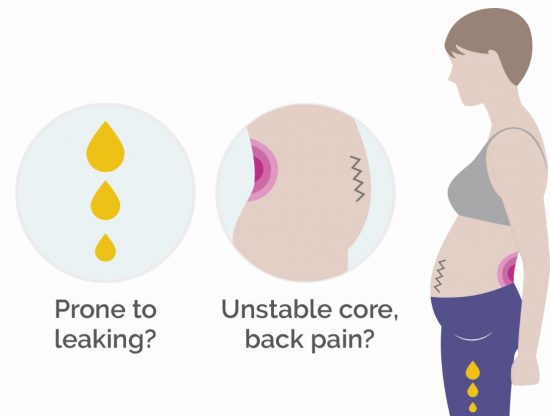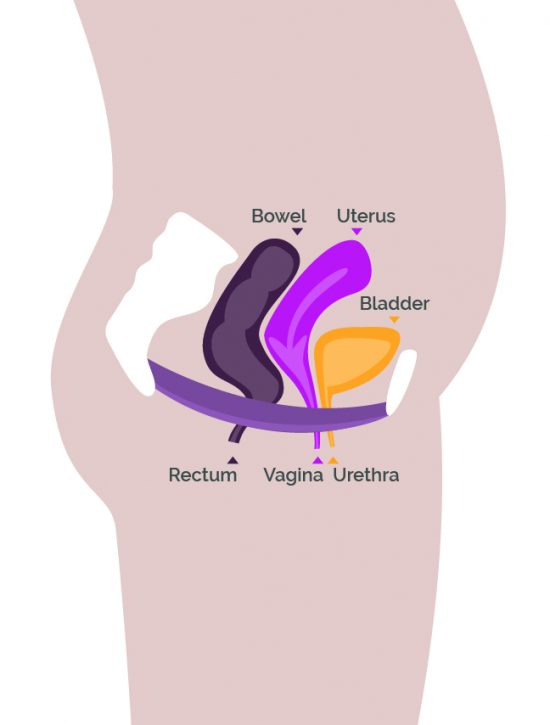Wendy Powell, internationally recognised as a leading postnatal fitness trainer, answers some common questions from new mums and introduces her medically endorsed online restorative exercise programme, MUTU System.


Whether you have a caesarean section or a vaginal birth, most women experience strain on their pelvic floor when having a baby. Your pelvic floor has been supporting extra weight and pressure throughout your pregnancy and this will have had some effect, regardless of how you give birth. Those who have a vaginal birth may experience further trauma to their pelvic floor during the delivery of the baby as a result of tearing or an episiotomy.
Surgical trauma leads to the build-up of scar tissue which can result in a loss of sensitivity and functionality in the affected area.[1] In the case of pelvic floor trauma, this lack of functionality may lead to bladder incontinence or occasional ‘leaking’ which is experienced by one in three women.
The best way to heal any scar tissue is through circulation – moving around – along with great nutrition and hydration. Even just gentle walking after having a baby can encourage healing and help to restore damage to the pelvic floor caused by childbirth.[2]
Like any other trauma, pelvic floor and abdominal issues caused during pregnancy and birth are injuries that need to be healed. They can be fixed but sit ups, planks and high impact exercises are not the way to achieve this. After having a baby, it is important to restore the stomach muscles and pelvic floor gradually, understanding and connecting the core muscles and ensuring they are functioning before moving onto any kind of strengthening exercises. But before you do this, we recommend speaking with your GP, midwife or health visitor.
Pelvic floor trauma will slowly heal by itself over time but restored muscle function – the ability to control leaking – may require some help, in the form of targeted reconnection exercises and strengthening.[3]
Not necessarily. Some women find that their bodies return to their ‘normal’ quicker than others. There are also varying degrees of problems and it is important that women have an understanding of what is and isn’t ‘normal’. The word ‘incontinence’ can sound severe, like something only old ladies need to worry about, but if you experience any leaking of urine, back or pelvic discomfort, or a domed stomach that leaves you still looking pregnant, you may be suffering from a damaged pelvic floor or diastasis recti (also known as abdominal separation) and these problems can be fixed.
Different! It varies for every woman, but everyone’s body will look and feel different immediately after giving birth. When you go to the toilet in the early days after birth, you may feel like your insides are going to fall out – this is normal (and they won’t) and you will be sore in lots of places. Your body changed gradually over 9 months and it isn’t realistic to expect it to bounce back to its pre-pregnancy form immediately. Issues like the ability to control urine and stools may not rectify themselves instantly after having your baby. You should expect your body to take around 9-12 months to heal fully.
Diastasis Recti is the result of excessive intra-abdominal pressure pushing outwards, that isn’t being controlled by your core as it should be. This can lead to a stomach that still ‘sticks out’ like it did when you were pregnant. It happens when the body is not aligned in a way that allows the core and pelvic muscles to do their job properly. This happens because your core is weak and not functioning as it should.[4]
It is unwise to return to an intensive pre-baby exercise routine too soon after giving birth. You should speak to your GP or health visitor, or wait until after your six week postnatal check. Going straight back to high impact exercise when you have a weakened core and pelvic floor is essentially an attempt to strengthen something that doesn’t work, which is impossible. If you are considering any kind of intensive, high impact workout after pregnancy it is important that your core is fully healed first, to avoid any further damage.

MUTU System is for women who want their bodies to look, feel and function better after having a baby. Medically endorsed, MUTU System is designed for women who want a core and pelvic floor that works.
An international best-selling, realistic and supportive exercise and recovery programme, MUTU is a solution for diastasis recti, pelvic floor weakness and a core that isn’t functioning as it should be.[5]
Founded by postnatal fitness expert Wendy Powell, the MUTU System is an award-winning online restorative exercise programme, consisting of a series of real-time online workout videos. Wendy is an expert in post-baby bodies and is able to advise on how to keep them safe, strong and functioning as well as how to feed them correctly.
MUTU System is medically approved and recommended by Women’s Pelvic Health Specialists around the world including Physiotherapists, Physical Therapists and Sex Therapists. With more than 38,000 members worldwide, MUTU System is an internationally respected programme with a growing community of supportive, motivational MUTU Mamas all around the world.
[1] https://www.nhs.uk/conditions/pregnancy-and-baby/your-body-after-childbirth/
[2] https://www.livestrong.com/article/166660-the-effects-of-scar-tissue-after-surgery/
[3] https://www.nhs.uk/conditions/urinary-incontinence/
[4] https://www.nhs.uk/conditions/pregnancy-and-baby/your-body-after-childbirth/, https://nutritiousmovement.com/tag/pelvic-floor-disorder-and-alignment/